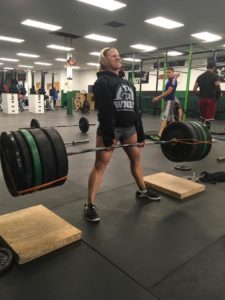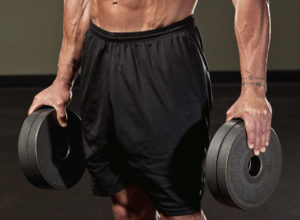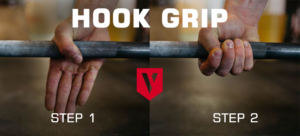By Joe Black
 You are ready to smash your 5-rep max deadlift. The first two reps are a piece of cake, but by the third you feel your grip going. On the fourth rep, the bar is barely in your hands and you are hanging on with your fingers. The bar barely breaks off the ground on the fifth rep because your grip is fried. Your posterior strength was more than adequate for you to hit a PR, but the limiting factor was your grip strength!
You are ready to smash your 5-rep max deadlift. The first two reps are a piece of cake, but by the third you feel your grip going. On the fourth rep, the bar is barely in your hands and you are hanging on with your fingers. The bar barely breaks off the ground on the fifth rep because your grip is fried. Your posterior strength was more than adequate for you to hit a PR, but the limiting factor was your grip strength!
Let’s make sure this situation above never happens to you. Here is how to do that.
3 Types of Grip
First, it helps to understand the different grip types you’ll be taught at a weighlifting and fitness gym. There are three types of grip:
- Crushing: the grip between your palm and fingers. Think gripping the bar for a deadlift or shaking hands.
- Support: the grip when you hold something for a long time. Think pull-ups or carrying groceries from your car.
- Pinch: the grip between your fingers and thumb. Think squeezing a bumper plate or opening a jar.
At our fitness gym, we mostly use crushing and support grip strength. This is developed when we do movements such as deadlifts, pull-ups, toes to bar, carries, rows, Olympic lifts, and kettlebell swings.
It is beneficial to train all three grip types, however, your focus will mostly be on crushing and support.
5 Ways to Improve Grip Strength
Below are five great ways to improve your grip strength. You can work this into daily WODs or come in during open gym to get extra work in.
- Farmer Carries: When farmer carries are written with the weight recommendation of “as heavy as possible” (AHAP), do not take this as a suggestion or an opportunity to rest during the WOD. Farmer carries are a GREAT tool to build grip strength. Not only that, but they provide an added benefit of a full body workout that increases core stability and your ability to breath under tension.
- Deadlifts: When deadlifts are programmed, take that as an opportunity to work your grip strength. As you build up to a working set, use a pronated grip on the bar (palms facing your body) as opposed to a mixed grip (one palm facing forward, one palm facing your body). Squeeze the bar hard with your palms and wrap your thumb around the outside of your fingers. Even during your working sets, you can make it harder by using a pronated grip or by switching up your mix grip. For example, if you have 4 working sets, you can do two sets with your right palm facing forward and left palm facing your body then switch so your left palm is facing forward and your right palm is facing your body.
- Active & Passive Bar Hangs: This was discussed in a blog post about pull-ups, but an easy way to improve grip strength is to add some active or passive hangs (for as long as possible) before or after class. Grip the bar with your palm and squeeze your fingers with your thumbs. Three sets, hanging as long as possible, will help.
- Plate Pinches: Grab two 5# or 10# steel plates in each hand and squeeze your fingers and thumbs together. Start this from the ground and stand them up, holding them for as long as you can. Start light and continue to add weight as you progress.

- Hammer Curls (with a twist): Hammer curls have already made an appearance during the WOD’s accessory work and you can slightly alter these to make them more grip intensive. Usually, a hammer curl is done with the head of the dumbbell at 12 o’clock (a neutral grip). To target your wrist extensor muscle group, which stabilizes your wrist and elbow joints so that bigger flexor muscle groups fire and activate for actions like gripping, turn the head of the dumbbells slightly in (1 o’clock on your left hand and 11 o’clock on your right hand). Slowly curl the dumbbell and squeeze hard at the top of the movement. Get that pump!
One (Almost) Immediate Way to Improve Your Grip
Improving your grip strength takes time, just like anything else, but you can almost immediately improve your grip strength, especially on the Olympic lifts, by using a hook grip.
With a hook grip, you take your thumb, wrap it around the bar and then wrapped your fingers around your thumb. The strength of your thumbs in this hook position, coupled with your fingers’ pressure around your thumb and the bar, create far more friction and thus a stronger grip.
 Be warned: this is most likely going to be an uncomfortable position at first. It will take time for your thumbs to get used to this grip. If you want to set PRs in the Olympic lifts, you need to learn the hook grip. Slowly work this into your lifting and consider taping your thumbs to lessen some of the discomfort.
Be warned: this is most likely going to be an uncomfortable position at first. It will take time for your thumbs to get used to this grip. If you want to set PRs in the Olympic lifts, you need to learn the hook grip. Slowly work this into your lifting and consider taping your thumbs to lessen some of the discomfort.
Take Action
If grip strength is an area that needs improvement, take action today. 1-2 exercises, 1-3 times per week should be more than enough. The more consistently you work at it, the quicker your strength will improve. If you’re not currently with a box, contact our fitness gym today and we’ll get you in touch with the right physical trainer!
